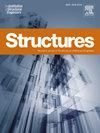采用ACI 544.2R落锤冲击试验新方法测定不同花纹多层纤维增强混凝土冲击后的残余抗压强度
IF 4.3
2区 工程技术
Q1 ENGINEERING, CIVIL
引用次数: 0
摘要
ACI 544.2 R重复冲击试验的主要缺点是费时费力。本文提出了压缩后冲击(CAI)测试的概念,以消除这些缺点,即显著减少打击的次数,在某些情况下可以达到数千次。试验程序是采用与ACI 544.2 R试验相同的设置,测量圆盘试样受到几次冲击前后的CAI,即载荷通过置于其上的金属球传递到圆盘试样上。当前工作的另一个显著成就是对具有不同模式(即纤维层数、序列和类型)的多层纤维增强混凝土(FRCs)的CAI进行了研究,以获得FRCs的最佳抗冲击性。使用了三种不同类型的混凝土:素混凝土(PC)、聚丙烯(PP) FRC和钢(ST) FRC。单层、双层和三层FRCs由这些混凝土制成,具有不同的序列/图案,以面对冲击器。本文提出的试验和标准试验所测得的极限静压缩载荷之间存在一定的逻辑关系。ST - FRC是抗接触应力性能最好的混凝土。采用威布尔分布对分散试验结果进行分析。统计结果与本研究结果具有较好的一致性,变异系数小于0.25。对于单层试件,ST试件的残余强度指标(RSI)最高,为91 %,其次是PP试件,为80 %,最后是PC试件,为65 %。具有外ST层(受冲击器影响)的两层试件的CAI比其他两层试件模式具有更高的冲击能力(RSI = 88 %)。此外,具有两层ST FRC和内层PC层的三层试件显示出最高的三层模式抵抗冲击载荷(两次冲击后RSI = 90 %)。因此,屏蔽层厚度是控制结构元件抗冲击性能提高的主要参数。最后,本文提出的ACI 544.2 R试验程序可用于多层FRCs或其他FRCs的抗冲击性测试,大大节省了时间和精力。本文章由计算机程序翻译,如有差异,请以英文原文为准。
Implementing a novel procedure of ACI 544.2R drop-weight impact test to measure the residual compressive strength after impact of multi-layered fiber-reinforced concrete with different patterns
The main drawbacks of ACI 544.2 R repeated impact test are the time and effort consumed. This paper proposes the compressive after-impact (CAI) test concept to eliminate such disadvantages, i.e., to markedly reduce the number of blows, which can reach thousands in certain cases. The test procedure was to measure the CAI of the disc specimens before and after being subjected to a few blows by the same setup of the ACI 544.2 R test, i.e., the load is transmitted to the disc specimen through the metallic ball resting on it. Another notable achievement in the current work is the investigation of the CAI of multi-layered fiber-reinforced concretes (FRCs) with different patterns, i.e., layers, sequences, and types of fibers—to obtain optimal impact resistance for FRCs. Three different types of concrete were used: plain concrete (PC), polypropylene (PP) FRC, and steel (ST) FRC. Single-, two-, and three-layered FRCs were made from these concretes with different sequences/patterns for facing the impactor. The ultimate static compressive loads measured by the proposed and standard tests showed a logical relationship between them. ST FRC showed the best kind of concrete for resisting such contact stress. The Weibull distribution was used to analyze the scattered test results. The statistical results showed good consistency of the present results, as the coefficient of variation was less than 0.25. For single-layered specimens, the ST specimen showed the highest Residual Strength Indicator (RSI), at 91 %, followed by the PP specimen, at 80 %, and finally, the PC specimen at 65 %. CAI of two-layered specimens with an outer ST layer (subjected to the impactor) showed higher impact capacity (RSI = 88 %) than other two-layered specimen patterns. Furthermore, a three-layered specimen with two layers of ST FRC and an inner PC layer showed the highest three-layered patterns resist the impact load (RSI = 90 % after two blows). Therefore, the thickness of the shielded layer is the main parameter controlling the improvement of a structural element's impact resistance. Finally, the proposed ACI 544.2 R test procedure can be adopted to measure the impact resistance of multi-layer FRCs or other FRCs, consuming significantly less time and effort.
求助全文
通过发布文献求助,成功后即可免费获取论文全文。
去求助
来源期刊

Structures
Engineering-Architecture
CiteScore
5.70
自引率
17.10%
发文量
1187
期刊介绍:
Structures aims to publish internationally-leading research across the full breadth of structural engineering. Papers for Structures are particularly welcome in which high-quality research will benefit from wide readership of academics and practitioners such that not only high citation rates but also tangible industrial-related pathways to impact are achieved.
 求助内容:
求助内容: 应助结果提醒方式:
应助结果提醒方式:


